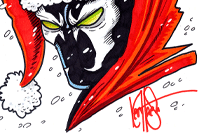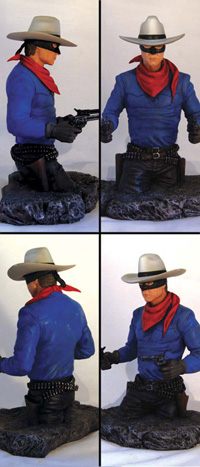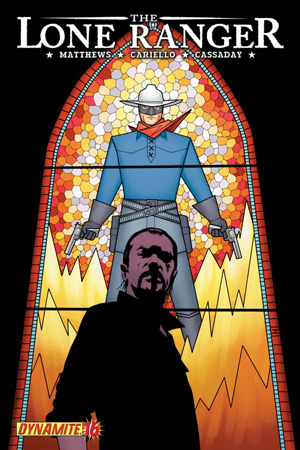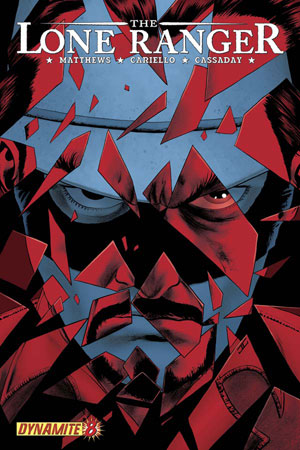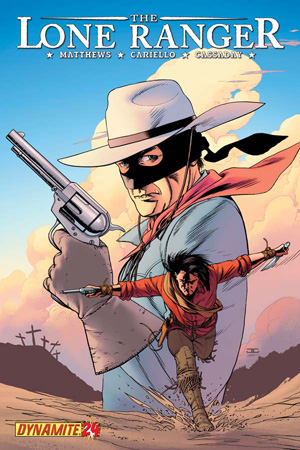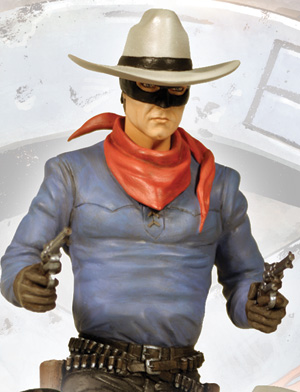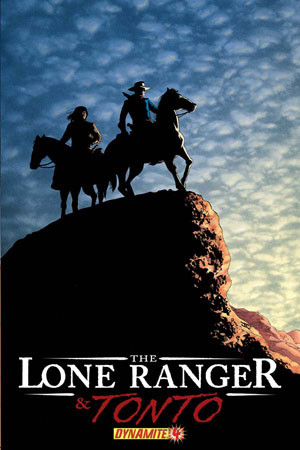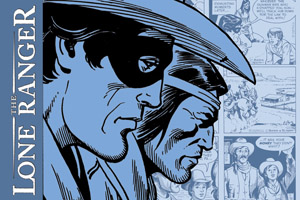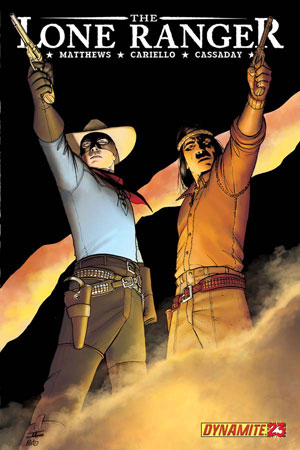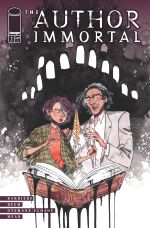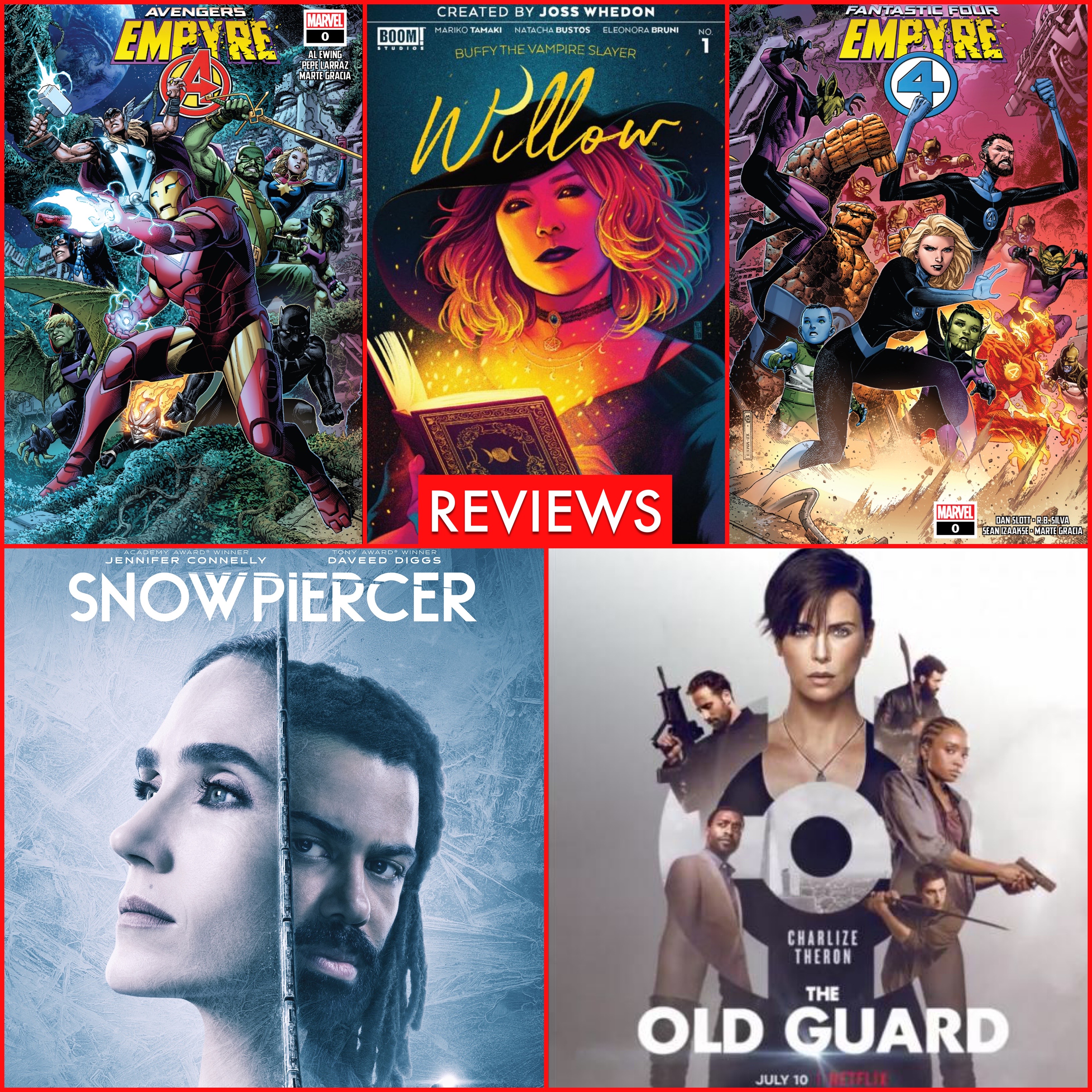|

|
THE LONE RANGER The Lone Ranger was an American long-running early radio and television show created by George W. Trendle (with considerable input from station staff members), and developed by writer Fran Striker.
The titular character is a masked Texas Ranger in the American Old West, who gallops about righting injustices, usually with the aid of a clever and laconic American Indian sidekick called Tonto, and his horse Silver. He would famously say "Hi-yo Silver, away!" to get the horse to gallop.
On the radio and TV-series, the usual opening announcement was: "A fiery horse with the speed of light, a cloud of dust, and a hearty 'Hi-yo Silver!' The Lone Ranger!" In later episodes the opening narration ended with the catch phrase "Return with us now to those thrilling days of yesteryear.... The Lone Ranger Rides Again!" Episodes usually ended with one of the characters lamenting the fact that they never found out the hero's name ("Who was that masked man?"), only to be told, "Why, that was The Lone Ranger!" as he and Tonto ride away. The theme music was the "cavalry charge" finale of Gioacchino Rossini's William Tell Overture, now inseparably associated with the series, which also featured many other classical selections as incidental music including Wagner, Mendelssohn, Liszt, and Tchaikovsky.
Inspiration for the name may have come from The Lone Star Ranger, a novel by Zane Grey. Karl May's tales of Old Shatterhand and Chief Winnetou may have influenced the creation of the concept; the legends of Robin Hood and the popular character Zorro was also a likely inspiration.
Birth of the Radio Series
The first of 2,956 episodes of The Lone Ranger "premiered" on radio on January 30, 1933 on WXYZ radio in Detroit, Michigan and later on the Mutual Broadcasting System radio network and then on NBC's Blue Network (which became ABC). Elements of The Lone Ranger story were first used in an earlier series Fran Striker wrote for a station in Buffalo, New York.
The hero is a Texas Ranger named Reid, who, as the series begins, was pursuing the criminal Butch Cavendish and his gang with a group of other rangers. The leader of the group of rangers was stated to be Captain Reid, his brother. (Some later radio reference books, beginning with The Big Broadcast in the 1970s, erroneously claimed that the two brothers' first names were John and Dan, respectively; however, use of their first names was deliberately avoided on both the radio and television programs, while at least one newspaper obituary upon Fran Striker's 1961 death and a 1964 Gold Key Comics retelling of the origin both stated that The Lone Ranger's given name was "Dan;" it must be acknowledged that the 1981 big-screen version, The Legend of The Lone Ranger, gave the names of John and Dan a degree of official standing, although the completely different names found in the 2003 TV-movie/unsold series pilot undercuts that; in any event, the name of Captain Reid's son, and the Ranger's nephew, a later character who became a sort of juvenile sidekick to the Masked Man, was Dan Reid.) The party finds itself in a murderous ambush arranged by Cavendish and a man named Collins, who has infiltrated the Rangers for the gang as a Scout, that seemingly leaves every ranger dead. Then Cavendish shoots Collins in the back, reasoning that someone who would betray the rangers could also betray his gang.
Reid's childhood friend, a Native American known as Tonto (his tribe was seldom specified, but some books say he was probably supposed to be an Apache, while the radio programs identified him as a Potawatomi), finds the party and finds Reid alive. Tonto takes him to safety and nurses him back to health. Tonto reminds Reid of when they were young, and Reid had rescued Tonto after renegade Indians had murdered his mother and sister and left him for dead. Reid gave him a horse, and Tonto insisted that Reid accept a ring. It is by this ring that Tonto recognizes Reid.
(This is actually a retroactive change to Tonto's origin. As originally presented, in the Dec. 7, 1938 radio broadcast, Reid had already been well-established as The Lone Ranger when he met Tonto. In that episode, "Cactus Pete", a friend of The Lone Ranger tells the story of how the masked man and Tonto first met. According to that tale, Tonto had been caught in the explosion when two men dynamited a gold mine they were working. One of the men wanted to kill the wounded Tonto, but The Lone Ranger arrived on the scene, and made him administer first aid. The man subsequently decided to keep Tonto around, intending to make him the fall guy when he would later murder his partner. The Lone Ranger foiled both the attempted murder and the attempted framing of Tonto. No reason was given in the episode as to why Tonto chose to travel with The Lone Ranger, rather than continue about his business. A reasonable assumption would be that he felt a sense of gratitude to the man).
While Reid recovers, Tonto buries the dead rangers. Reid vows to bring the killers and others like them to justice. So he asks Tonto to make a sixth grave to make people think that he had died as well. But Collins is also still alive, and tries to kill the pair so he can take Tonto's horse, Scout. But he falls to his death while trying to drop a rock on Reid. Thus perished the only other man who knew that Reid survived.
By happenstance, the pair discovers a magnificent white stallion, wounded by a buffalo. Reid and Tonto nurse the stallion back to health, which is then adopted by Reid as his mount, Silver. Whenever the Ranger mounts Silver he shouts, "Hi-yo, Silver, away!" which besides sounding dramatic, originally served to tell the radio audience that a riding sequence was about to start.
They also find an old mentor of Reid's, who discovered a lost silver mine some time back. Reid's mentor is the only one besides Tonto who knows the identity of The Lone Ranger. And he is willing to work it and supply Reid and Tonto as much silver as they want! Using material from his brother's old Texas Ranger vest, Reid fashions the mask that will mark him as The Lone Ranger. In addition, The Lone Ranger decides to use only silver bullets, as a reminder of his vows to fight for justice, and never to shoot to kill. Together, The Lone Ranger and Tonto wander the Old American West helping people and fighting injustice where they find it. The Lone Ranger was also a master of disguise, and in particular would often infiltrate an area as the "Old Prospector", an old-time miner with a full beard, so that he can go places where The Lone Ranger would never fit in, usually to gather intelligence about criminal activities.
According to "The Legend of Silver", a radio episode broadcast September 30, 1938, before acquiring Silver The Lone Ranger rode a chestnut mare called Dusty. After Dusty was killed by a criminal that Reid and Tonto were tracking, Reid saved Silver's life from an enraged buffalo, and in gratitude Silver chose to give up his wild life to carry him. Silver's father was called Sylvan, and his mother was Musa.
The origin of Tonto's horse, Scout, is less clear. For a long time Tonto rode a white horse called White Feller. In the episode titled "Four Day Ride," which aired August 5, 1938, Tonto is given a paint horse by his friend, Chief Thundercloud, who then takes and cares for White Feller. Tonto rides this horse, and simply refers to him as "Paint Horse," for several episodes. The horse is finally named Scout in the episode "Border Dope Smuggling," which was broadcast on September 2, 1938. In another episode, the lingering question of Tonto's mode of transport was resolved when the pair found a secluded valley and The Lone Ranger, in an urge of conscience, released Silver back to the wild. The episode ends with Silver returning to the Ranger bringing along a companion who becomes Tonto's horse, Scout.
Actors who played The Lone Ranger
On radio, The Lone Ranger was played by several actors, including John L. Barrett who played the role on the test broadcasts on WEBR during early January, 1933; George Seaton (under the name George Stenius) from January 31 to May 9 of 1933; series director James Jewell and an actor known only by the pseudonym "Jack Deeds" (for one episode each), and then by Earle Graser from May 16, 1933 until April 7, 1941. On April 8, Graser died in a car accident, and for five episodes, The Lone Ranger was unable to speak beyond a whisper, with Tonto carrying the action. Finally, on the broadcast of April 18, 1941, deep-voiced performer Brace Beemer, who had been the show's announcer for several years, took over the role and played the part until the end. Fred Foy, also an announcer on the show, took over the role on one broadcast on March 29, 1954, when Brace Beemer had a brief case of laryngitis. Tonto was played throughout the run by actor John Todd (although there were a few isolated occasions when he was substituted with Roland Parker, better known as Kato for much of the run of sister series The Green Hornet), and other supporting players were selected from Detroit area actors and studio staff. These included Jay Michael (who also played the lead on Challenge of the Yukon aka Sgt. Preston of the Yukon), Bill Saunders (as various villains, including Butch Cavendish), Paul Hughes (as the Ranger's friend Thunder Martin and as various army colonels and badmen), future movie star John Hodiak, Janka Fasciszewska (under the name Jane Fae), and others. The part of nephew Dan Reid was played by various child actors, including Bob Martin, James Lipton, and Dick Beals.
The last new radio episode of The Lone Ranger was aired on September 3, 1954.
Green Hornet
The radio series also inspired a spin-off called The Green Hornet which depicts Reid's grand nephew, Britt Reid, originally played by Al Hodge, who in contemporary times fights crime with a similar secret identity and sidekick, Kato. However, the properties have been acquired by different interests and the familial link has been ignored in the Western character's various incarnations. Not surprisingly, The Lone Ranger-Green Hornet connection is one of the most important parts of the Wold Newton family, which connects disparate fictional characters.
Other media
The series also inspired numerous comic books, two movie serials, books, a live action television series (1949-1957) starring Clayton Moore as The Lone Ranger (which is probably the best known treatment of the franchise.)
Film Serials
The Lone Ranger serials from Republic Pictures are something of enigmas to many serial and Lone Ranger fans, because they are very rare and hard to find. The few prints that are in circulation of the first one do not contain the complete serial and are usually either subtitled in Spanish or dubbed in French. The hero's identity is unknown even to the audience here, with six men suspected of being behind the mask. As the chapters unreel, they are killed off one by one, but each actually appears in the costume in various scenes. As the character played by Lee Powell is ultimately revealed to be the true identity of the Masked Man, that actor is often given sole credit for the part. Two other suspects were played by Bruce Bennett and George Montgomery, then still billed under their respective birth names of Herman Brix and George Letz. The second serial, The Lone Ranger Rides Again, came out in 1939 and starred Robert Livingston. The depiction here is as inconsistent with its predecessor as either is with the radio original. The only known reels of this production were discovered in Mexico and have Spanish subtitles. George W. Trendle disliked the treatment his character was given here. However, he retained long-term ownership, and when given the masters, he made no effort to store them properly. Consequently, they soon deteriorated, and only those foreign prints survive.
Television Series
A much more well known and influential adaptation of The Lone Ranger was the (1949-1957) television series starring Clayton Moore (though with John Hart as The Lone Ranger from 1952-1954) and Jay Silverheels as Tonto. The live-action TV series initially featured Gerald Mohr as the episode narrator. He was also narrator for seven episodes of the radio series in 1949, 1950 and 1952. Fred Foy served as both narrator and announcer of the radio series from 1948 to its finish, and became announcer of the TV version when story narration was dropped there.
Although George W. Trendle retained the title of Producer, he recognized that his experience in radio would not be adequate for producing the television series. For this, he hired veteran MGM film producer Jack Chertok. Chertok served as the producer for the first 182 episodes, as well as a rarely seen 1955 color special, retelling the origin.
The first 78 episodes were produced and broadcast for 78 consecutive weeks without any breaks or reruns. Then the entire 78 episodes were shown again, before any new episodes were produced.
When it came time to produce another batch of 52 episodes, there was a wage dispute with Clayton Moore (until his death, the actor insisted the problem was creative differences), and John Hart was hired to play the role of The Lone Ranger. Once again, the 52 new episodes were aired in sequence, followed by 52 weeks rerunning them. Despite expectations that the mask would make the switch workable, Hart was not accepted in the role, and his episodes were not seen again until the 1980s.
At the end of the fifth year of the television series, Trendle sold The Lone Ranger rights to Jack Wrather (Aug 3, 1954). Wrather immediately rehired Clayton Moore to play The Lone Ranger and another 52 episodes were produced. Once again, they were broadcast as a full year of new episodes followed by a full year of reruns.
The final season saw a number of changes, the most obvious at the time being an episode count of the by-then industry standard 39. Wrather put money out of his own pocket to film in color--then-perennial third place finisher ABC telecasting only in black and white--and to go back outdoors for more than just second-unit style action footage, the series having been otherwise restricted to studio sound stages after the first filming block. Another big change, not readily detectable by the viewers, was replacing Jack Chertok with producer Sherman A. Harris. By this time, Chertok had established his own television production company and was busy producing other shows.
Wrather decided not to negotiate further with the network and took the property to the big screen, canceling TV production. The last new episode of the color series was broadcast June 6, 1957 and the series ended September 12, 1957, although ABC reaped the benefits of daytime reruns for several more years. Wrather's company produced two modestly budgeted theatrical features, "The Lone Ranger" (1956) (the cast included former child actress Bonita Granville, aka Mrs. Wrather) and "The Lone Ranger and the Lost City of Gold" (1958). Exactly what happened remains unclear, but Wrather changed distributors between films, indicating some problem.
See also List of Lone Ranger Television Episodes
The Return of The Lone Ranger
An attempt by CBS to revive the series in 1961, Return of The Lone Ranger, did not get past the pilot stage. The Lone Ranger was played by Tex Hill in the pilot.
The Legend of The Lone Ranger (1981)
So far, no modern remake of The Lone Ranger has proven popular, with 1981's Legend of The Lone Ranger causing much upset among fans when the movie studio filed a suit to prevent Clayton Moore from appearing as The Lone Ranger anywhere else, and then gave a cameo to his unsuccessful TV replacement, John Hart; the film was a spectacular failure. It did not help that lead actor Klinton Spilsbury's lines had to be overdubbed by James Keach.
The Lone Ranger (2003)
In 2003 the WB network aired a two hour Lone Ranger TV movie, the pilot for a possible series. However the movie was greeted unenthusiastically; the Reid family name became Hartman, and while there was still an empty grave alongside those of the five dead Rangers, its supposed occupant was unidentified, and the hero maintained his unmasked identity as well, becoming a cowboy version of Zorro. Consequently the project was shelved.
Animation
In 2001, Goodtimes Home Video released a videotape called "The Lone Ranger: The Lost Episodes." Along with clips from the first serial, trailers for the two post-TV series features, commercials with Moore and sometimes Silverheels in character, and two full episodes, there was a cartoon short, said to date from the late 1930s, but, with on-screen dialogue balloons instead of recorded voices, it seemed to come from the silent era. It remains a mystery.
An animated series of The Lone Ranger ran from 1966 to 1968 on CBS; the show lasted thirty episodes (invariably split into three separate shorts, with the middle segment being a solo adventure for Tonto, so that there were 90 installments in total), and the last episode aired on the 9th of March 1968. The Lone Ranger was featured, along with Zorro and Tarzan in "Adventure Hour" cartoon shorts in the early 1980s, produced by Filmation. These episodes featured William Conrad as the voice of the Masked Man, though he was listed in the credits as "J. Darnoc" (Conrad spelled backwards). Conrad starred in the original radio version of Gunsmoke as Marshal Matt Dillon and was the announcer/narrator for the cartoon escapades of Rocky & Bullwinkle. This time he had 14 episodes, split into two adventures at a time, for a total of 28 stories.
Toys
There have been many Lone Ranger toys released over the years. One of the most successful was a line of 8-inch action figures and accessories released by Gabriel Toys in 1973. In 2006 it was announced The Lone Ranger will be made as an action figure in the new "Indie Spotlight" toy line by Shocker Toys.
Video Games
The "Lone Ranger" series also inspired a NES video game, simply titled The Lone Ranger, produced by Konami in 1990.
Novels
The first Lone Ranger novel appeared in 1936, and eventually 18 volumes were published, as listed below. The first book was written by Gaylord Dubois, but the others by Fran (Francis Hamilton) Striker. Striker also re-edited, and re-wrote parts of later editions of the first novel. First published between 1936 and 1956 in hardback by Grosset and Dunlap, these stories were reprinted in 1978 by Pinnacle Books.
• The Lone Ranger (1936)
• The Lone Ranger and the Mystery Ranch (1938)
• The Lone Ranger and the Gold Robbery (1939)
• The Lone Ranger and the Outlaw Stronghold (1939)
• The Lone Ranger and Tonto (1940)
• The Lone Ranger at the Haunted Gulch (1941)
• The Lone Ranger Traps the Smugglers (1941)
• The Lone Ranger Rides Again (1943)
• The Lone Ranger Rides North (1943)
• The Lone Ranger and the Silver Bullet (1948)
• The Lone Ranger on Powderhorn Trail (1949)
• The Lone Ranger in Wild Horse Canyon (1950)
• The Lone Ranger West of Maverick Pass (1951)
• The Lone Ranger on Gunsight Mesa (1952)
• The Lone Ranger and the Bitter Spring Feud (1953)
• The Lone Ranger and the Code of the West (1954)
• The Lone Ranger and Trouble on the Santa Fe (1955)
• The Lone Ranger on Red Butte Trail (1956)
Comic Strip
King Features Syndicate distributed a newspaper strip of The Lone Ranger from September 1938 to December 1971. The original artist was Ed Kressy, but he was replaced in 1939 by Charles Flanders who drew the strip until its conclusion. In 1981 the New York Times Syndicate launched a second Lone Ranger strip. The strip was written by Cary Bates with art by Russ Heath. It ran until 1984. Two of the storylines were collected in a comic book by Pure Imagination Publishing in 1993.
Comic Books
DYNAMITE ENTERTAINMENT's The Lone Ranger #4 cover. Art by John Cassaday.In 1948 Dell Comics launched a comic book series which lasted 145 issues. This originally consisted of reprints from the newspaper strips, but later original content began with #7. Tonto got his own spin-off title in 1951, which lasted 31 issues, followed by Silver the horse in 1952, which ran to 34 issues. In addition Dell published three big Lone Ranger Annuals, and an adaptation of the 1956 film.
The Dell series ended in 1962, but Gold Key Comics began a new Lone Ranger series, initially reprinting material from the Dell comics, in 1964. Original content only began with issue #21, in 1975, but the magazine itself folded with issue #28 in 1977. Additionaly, Hemmets Journal AB published a three-part Swedish Lone Ranger the same year. Gaylord DuBois wrote many of The Lone Ranger, Tonto and Silver comic books for both Dell and Gold Key. He developed Silver, in the Hi Yo Silver comics, as a hero in his own right.
In 1994 Topps Comics produced a four issue mini-series, The Lone Ranger and Tonto, written by Joe R Lansdale and drawn by Timothy Truman.
The first issue of a new Lone Ranger series from DYNAMITE ENTERTAINMENT shipped September 6, 2006. It is unclear if it is to be a mini or an ongoing series. On September 15, 2006 DYNAMITE ENTERTAINMENT announced that The Lone Ranger #1 had sold out of its first printing. A second printing of the first issue was announced, a first for the company. While overall considered a critical success, the new series has received some backlash from classic Lone Ranger fans for its graphic depictions of violence.
Popular culture
Atticus Kent taking on the role of The Lone Ranger.Throughout the run of the situation comedy Happy Days, the Fonz (Henry Winkler) references The Lone Ranger as his hero. In one episode, the Cunninghams arrange a meeting between the Fonz and The Lone Ranger (portrayed on this occasion by John Hart) as a birthday surprise. The Fonz is left speechless until he utters the oft-cited and -parodied line, "I didn't even get a chance to thank him", after The Lone Ranger leaves him with a silver bullet and presumably "rides off into the sunset".
In the 1960s, legendary New York radio disc jockey, Dan Ingram of Top 40 powerhouse WABC (770) AM, parodied Tonto with his own character, "Pronto", in various on-air bits and promos. These included a "Kemosabe Card", offering listeners various benefits and sponsor discounts. Throughout his career, Ingram uses "Kemosabe" as a universal, one-to-one signature in greeting, and in closing his show for, his listeners ("Bye now Kemosabe!"). On his 1981 20th anniversary show, Ingram suggests a more socially conscious and contemporary "Pronto" has become an advocate for the American Indian Movement (AIM).
And on a note of irony, one of Ingram's co-workers during a portion of his tenure is none other than legendary station staff announcer, Fred Foy, perhaps the radio - and later television - drama's best-remembered announcer.
The Lone Ranger appeared in an amusing mid 1990 Rolo chocolate advert, in which he was put into a difficult situation as to with whom he should share his last Rolo, his beloved horse Silver or best friend Tonto. Hence the chocolates slogan Do you love anyone enough to give them your last Rolo?. (He gave the last Rolo to Silver, for which Tonto ended up punishing him).
Clayton Moore also appeared in a commercial for wrap-around sunglasses that darkened upon exposure to bright sunlight. Because Moore had made it a point never to appear in the media without his mask, the viewers saw an unfamiliar face whose familiar voice was hawking the product. When the sunglasses had completely darkened, replicating The Lone Ranger's mask, it was clear who he was -- but too late for most viewers to recall the unmasked face they'd seen half a minute earlier. His secret identity had once again been preserved.
The widespread popularity and admiration of the radio and TV series lent itself to inevitable parodies and takeoffs in cartoons and other popular media. Clayton Moore and Jay Silverheels were not above joining in the fun, playing their own characters in TV ads from time to time, for modern products such as "Aqua-Velva" after shave lotion and Amoco "Silver" gasoline.
One of the most entertaining of these commercials was for Jeno's Pizza Rolls, was written by Stan Freberg, and featured Clayton Moore and Jay Silverheels near the end. It's described fully at POV Online and can be viewed at Pizza Roll Commercial.
Famous Seventies singer-songwriter Jim Croce references The Lone Ranger in his song "You Don't Mess Around with Jim" with the admonition that "You don't tug on Superman's cape / You don't spit into the wind / You don't pull the mask off that old Lone Ranger / And you don't mess around with Jim." In addition, American singer-songwriter Lyle Lovett references Tonto and The Lone Ranger in his song "If I Had a Boat", from the album Pontiac. The lyrics include the following lines: "The mystery masked man was smart/He got himself a Tonto/'Cause Tonto did the dirty work for free/But Tonto he was smarter/And one day he said, 'Kemo Sabe/Kiss my ass, I bought a boat/I'm going out to sea!'"
The British music group Quantum Jump acheieved a UK hit single in 1979 with their song "The Lone Ranger". The song suggests a homoerotic context for the relationship between The Lone Ranger and Tonto ("Maybe Ranger he a poofter/Try it on with surly Tonto/Let me say to mister lawman/Tonto doesn't mind") but is better remembered for its distinctive chant of "Taumatawhakatangihangakoauauotamateapokaiwhenuakitanatahu", the name of a mountain in New Zealand.
The costume worn by Texas Tech's Masked Rider strongly resembles that of The Lone Ranger.
In the DC Comics Elseworlds title, Superman: A Nation Divided, Superman, after serving the Union through the Civil War and beyond, finds a message from Jor-El that says he is meant to lead the people of the west. He then fashions his ship into a silver horse and dons the traditional garb of The Lone Ranger, minus the mask, preparing to become the hero of the West. The last panel shows "Aticus Kent" atop his silver horse in the classic Lone Ranger pose.
Tonto and "Kemosabe"
Tonto greets The Lone Ranger with the expression "kemosabe", which has also been written "Kemo Sabe" or "Kemo Sabhay". The origin of this expression is somewhat unclear, but James Jewell, an early director of the radio series, said the name comes from a boy's camp located on Mullett Lake, Michigan that his father-in-law had run from 1911 to 1941. The translation was said to mean "trusty Scout". Fran Striker, the writer of The Lone Ranger scripts, said the actual expression was Ta-i ke-mo sah-bee, which he said meant "greetings trusty Scout". In the pilot of the Clayton Moore TV series, "Enter The Lone Ranger", Tonto explicitly states that "Kemosabe" means "trusty Scout". There has been a discussion about the origins of the word in The Straight Dope suggesting the word may be of either Ojibwe or Potawatomi origin. Link to straight dope.com
However, the phrase "faithful friend" has also been associated with the term Kemo Sabe. One such instance was in the 20th anniversary broadcast of the radio show, which recapped the Ranger's origin. In the scene where the wounded Ranger awakens and recognizes Tonto, he says, "years ago, you called me Kemo Sabe". Tonto replies, "That right, and you still Kemo Sabe. It mean, 'faithful friend'".
Various investigators have found other sources for this saying, some of them humorous and usually centering around the idea that "kemosabe" is actually an insult or vulgarity. For instance, a Far Side comic strip has the long-since retired Lone Ranger discovering (in an Indian dictionary) that "kemosabe" is an Apache expression for a "horse's rear end". In the early 1970s, Jay Silverheels appeared as a guest on The Tonight Show Starring Johnny Carson, playing Tonto, with Johnny Carson playing a career counselor. Tonto was seeking a new job after having spent "thirty lousy years" as the Ranger's faithful Indian companion. ("Him let me peek under mask once. No big deal!") As to why he was no longer working with the Masked Man, Tonto said, "Him find out what kemosabe means!"
In Homer and Jethro's parody of the song "Waterloo," they rendered one verse thus:
The Lone Ranger and Tonto rode the trail
Catchin' outlaws and throwin' them in jail
But the Ranger shot ol' Tonto 'cause it seems
He found out what Kemo Sabe means!
In Spanish, Tonto means "Fool". In English it was spoken "TAHNT-oh", vs. the Spanish "TON-to". Regardless, it is spelled the same way, and in Spanish-speaking countries, the character was renamed "Toro", meaning "Bull". In the Potawatami language, the word is supposed to mean "Wild One". The Potawatomi were the tribe that he was mentioned as belonging to in the radio dramas. In certain Spanish-speaking parodies, the name "Tonto" was still widely used, perhaps because Tonto was seen as foolish for seemingly always being the one taking a beating from the townspeople, as with an early Bill Cosby routine in which Tonto is finally fed up.
Lone Ranger: Tonto, you go to town.
Tonto: You go to hell, Kemo Sabe!
Lone Ranger: I want you to get the information.
Tonto: Information say Tonto no go to town. That's what information say.
The punchline of a popular Lone Ranger joke of the 1950s (or earlier) has taken on a memetic status of its own. The joke goes something like: LR: "Tonto! We're surrounded by hostile Indians!", Tonto: "What you mean WE, paleface?" or, just as commonly, "What do you mean WE, white man?" or even "Who's WE, white man?" In an issue of Mad Magazine, it appeared this way: LR: "Indians! Indians all around us! Well, Tonto, ol' kimosavee , it looks like we're finished!" Tonto: "What you mean: WE?"
Though Tonto was consistently portrayed as an intelligent and skilled warrior, later adaptations are notable for their efforts to remove his broken English, seen by some as stereotypical and demeaning in contrast to the character's other noble qualities.
The Lone Ranger "Theme"
Rossini's finale to the William Tell Overture, which was supposed to represent a cavalry charge, was thus the perfect music for the Ranger as he and Silver sped along. The very recognizable theme and its meter led to the following joke:
Question: Where does The Lone Ranger take his garbage?
Answer: To the dump, to the dump, to the dump-dump-dump!
Since the theme song was so closely associated with The Lone Ranger, an old joke is that a "true long hair" (classical music fan) was someone who could listen to the William Tell Overture without thinking of The Lone Ranger.[citation needed]
The Lone Ranger's Legacy
The character of The Lone Ranger fit closely with how America saw itself at the time, as a nation of believers in law and justice. On the premise of innocent until proven guilty, only the minimum force needed to subdue lawless citizens was to be used, to bring them to trial. This is explicitly stated in the very first TV episode. Right after the Ranger puts the mask on (which Tonto had fashioned from the vest belonging to his dead brother, Captain Reid), Tonto starts handing equipment to the Ranger:
Tonto: Here, guns, to kill bad men.
Reid: I'm not going to do any killing.
Tonto: You not defend yourself?
Reid: I'll shoot if I have to. But I'll shoot to wound, not to kill. If a man must die, it's up to the law to decide that, not the person behind a six-shooter!
Tonto: That's right, Kemo Sabe!
Tonto: You all alone now. Last man. You are lone Ranger.
Reid: Yes, Tonto... I am... The Lone Ranger!
This article uses material from Wikipedia and is licensed under the GNU Free Documentation License.All material is compiled from numerous sources and may not be accurate. Dynamic Forces, Inc and all of its subsidiaries cannot guarantee the validity of the content. |
 |

